13.1.1: The History of "Race" Concepts
- Last updated
- Save as PDF
- Page ID
- 136463
“Race” in the Classical Era
The earliest classification systems used to understand human diversity are evidenced by ancient manuscripts, scrolls, and stone tablets recovered through archaeological, historical, and literary research. The Ancient Egyptians had the Book of Gates, dated to the New Kingdom between 1550 B.C.E. and 1077 B.C.E (Figure 13.2). In one part of this tome dedicated to depictions of the underworld, scribes used pictures and hieroglyphics to illustrate a division of Egyptian people into the four categories known to them at the time: the Aamu (Asiatics), the Nehesu (Nubians), the Reth (Egyptians), and the Themehu (Libyans). Though not rooted in any scientific basis like our current understandings of human variation today, the Ancient Egyptians believed that each of these groups were made of a distinctive category of people, distinguishable by their skin color, place of origin, and even behavioral traits.
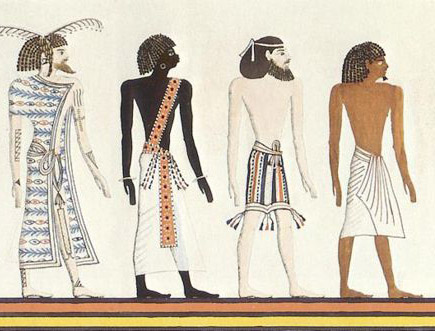 Figure \(\PageIndex{1}\): (from left to right) Depicting a Berber (Libyan), a Nubian, an Asiatic (Levantine), and an Egyptian, copied from a mural of the tomb of Seti I.
Figure \(\PageIndex{1}\): (from left to right) Depicting a Berber (Libyan), a Nubian, an Asiatic (Levantine), and an Egyptian, copied from a mural of the tomb of Seti I. Figure \(\PageIndex{2}\): Front page of Pliny the Elder’s Naturalis Historia.
Figure \(\PageIndex{2}\): Front page of Pliny the Elder’s Naturalis Historia.The Roman philosopher Pliny the Elder (23‒79 C.E.) also wrote about different groupings of people in his encyclopedia Naturalis Historia (Figure 13.3). In his opinion, all people fit under one of three categories: civilized peoples, barbarians, and monstrous individuals. Pliny the Elder’s work was deeply problematic. He believed that only Europeans were civilized and not monstrous-looking, while other groups of people lacked the ideal character and appearance. In both the cases of the Book of Gates and Naturalis Historia, the worldviews of those who wrote these volumes were also limited by how few and infrequent their encounters were with peoples elsewhere around the world—that is, those not residing in Europe, the Near East, or northern Africa. When faced with only the level of biological diversity they could see around them, distinguishing factors identified by these prominent thinkers relied simply on readily visible phenotypic traits, such as body size, skin color, and facial shape.
The most well-known of early documents is perhaps the Bible, where it is written that all humankind descends from one of three sons of Noah: Shem (the ancestor to all olive-skinned Asians), Japheth (the ancestor to pale-skinned Europeans), and Ham (the ancestor to darker-skinned Africans). Similar to the Ancient Egyptians, these distinctions were based on behavioral traits and skin color. More recent work in historiography and linguistics suggest that the branches of “Hamites,” “Japhethites,” and “Shemites” may also relate to the formation of three independent language groups some time between 1000 and 3000 B.C.E. With the continued proliferation of Christianity, this concept of approximately three racial groupings lasted until the Middle Ages and spread as far across Eurasia as crusaders and missionaries ventured at the time.
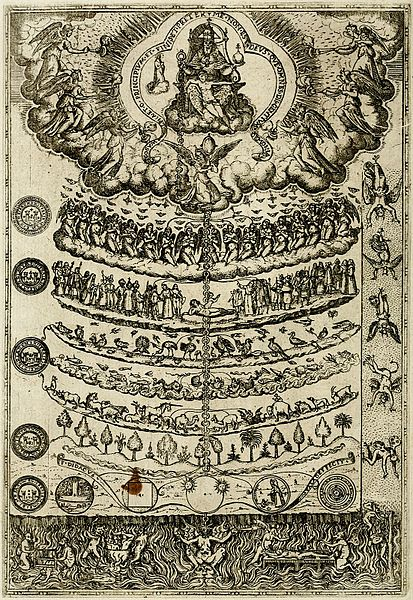 Figure \(\PageIndex{3}\): The Great Chain of Being from the Rhetorica Christiana by Fray Diego de Valades (1579).
Figure \(\PageIndex{3}\): The Great Chain of Being from the Rhetorica Christiana by Fray Diego de Valades (1579).Finally, there is also the “Great Chain of Being,” conceived by ancient Greek philosophers like Plato (427‒348 B.C.E.) and Aristotle (384‒322 B.C.E.). They played a key role in laying the foundations of empirical science, whereby observations of everything from animals to humans were noted with the aim of creating taxonomic categories. Aristotle describes the Great Chain of Being as a ladder along which all objects, plants, animals, humans, and celestial bodies can be mapped in an overall hierarchy (in the order of existential importance, with humans placed near the top, just beneath divine beings) (Figure 13.4). Where he writes about humans, Aristotle expressed the belief that certain people are inherently (or genetically) more instinctive rulers, while others are more natural fits for the life of a worker or slave. Nowadays, based on research by biological anthropologists, we currently recognize that these early systems of classification and hierarchization are unhelpful in studying human biological diversity. Both behavioral traits and physical traits are coded for by multiple genes each, and how we exhibit those traits based on our genetics can vary significantly even between individuals of the same population.
“Race” during the Scientific Revolution
The 1500s and 1600s saw the beginnings of the “Scientific Revolution” in European societies, with thinkers like Copernicus, Galileo, and Da Vinci publishing some of their most important findings. While by no means the first or only scholars globally to use observation and experimentation to understand the world around them, early scientists living at the end of the medieval period in Europe increasingly employed more experimentation, quantification, and rational thought in their work. This is the main difference between the work of the ancient Egyptians, Romans, and Greeks, and that of workers like Isaac Newton and Carl Linnaeus in the 1600s and 1700s.
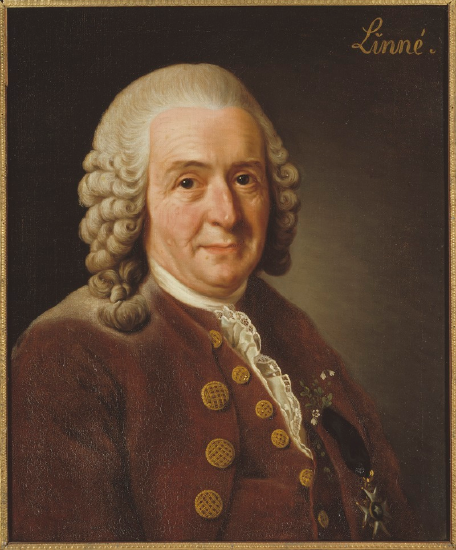 Figure \(\PageIndex{4}\): Carl Linnaeus.
Figure \(\PageIndex{4}\): Carl Linnaeus.Linnaeus is the author of Systema Naturae (1758), in which he classified all plants and animals he could observe under the first formalized naming system known as binomial nomenclature (i.e., how all organisms can be named by their genus and species, such as Homo sapiens or Pan troglodytes) (Figure 13.5). What was most anthropologically notable about Linnaeus’s taxonomy was that he was one of the first to group humans with apes and monkeys, after noting the anatomical similarities between humans and nonhuman primates. Linnaeus viewed the world in line with essentialism, a concept which dictates that there are a unique set of characteristics that organisms of a specific kind must have—organisms would fall outside taxonomic categorizations if they lacked any of the required criteria.
Despite these useful contributions to the biological sciences, Linnaeus still subdivided the human species into four varieties, with overtly racist categories based on skin color and “inherent” behaviors. According to him, Africans are all “black-skinned” and ruled by an erratic nature; Native Americans are “red” in skin tone and ruled by habit; Asians are “yellow-” or “brown-skinned” and ruled by belief; and Europeans are “white” and regulated by custom. These standards for categorization imply that Europeans are governed by carefully considered culture and custom, unlike the unthinking Asians and Indigenous Americans in his framework who normally act out of “habit” or “belief.” Moreover, Linnaeus’s traditional ranking also places sub-Saharan, dark-skinned Africans inferior to the other three. Wrongly so, European scientists during this period were not aware of their own biases skewing their interpretations of biological diversity. The conclusions and claims they came to, consciously or subconsciously, often fit such an age when the superiority of European cultures over others was a pervasive idea throughout these scientists’ social and political lives.
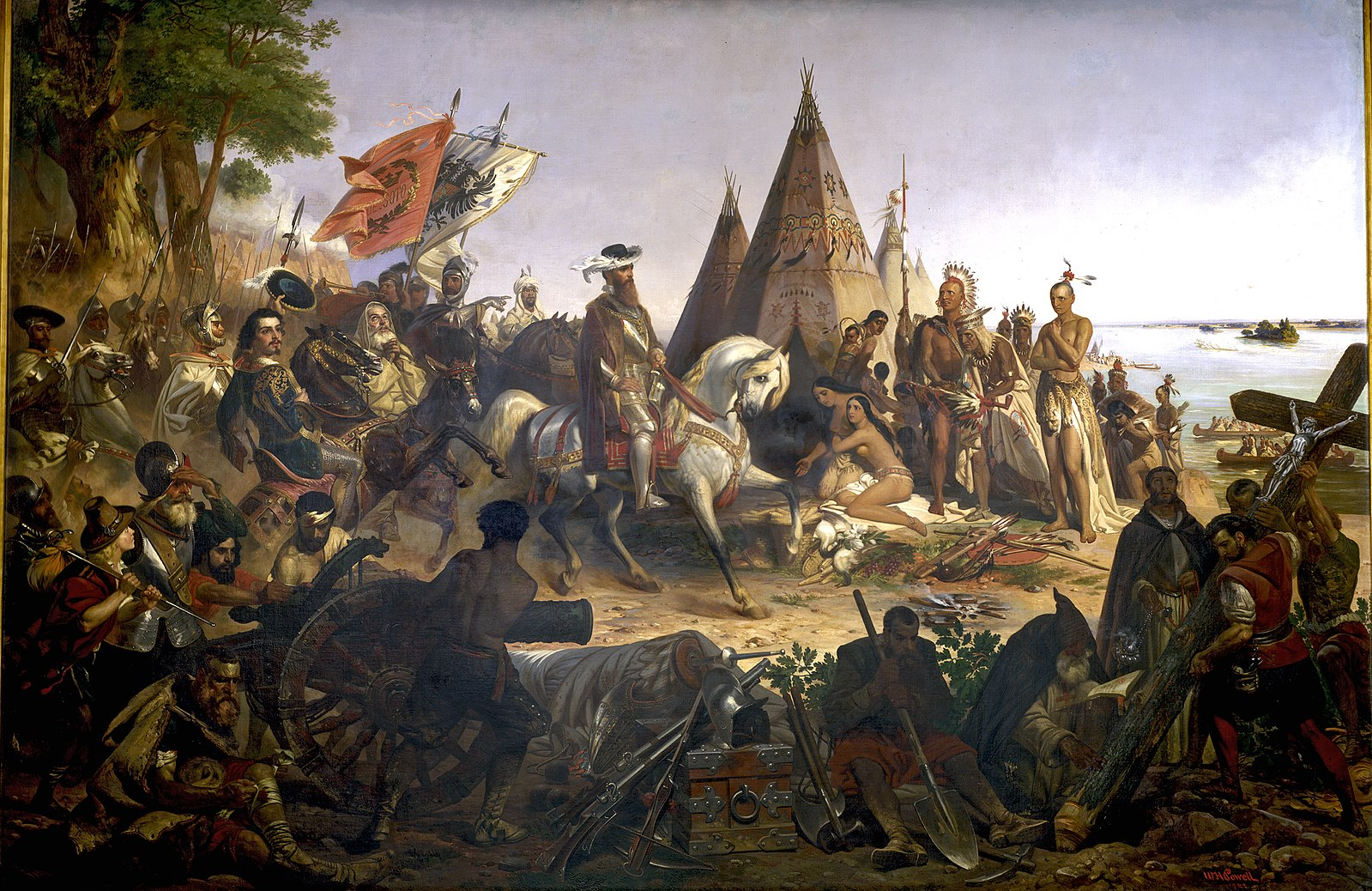 Figure \(\PageIndex{5}\): Discovery of the Mississippi by Spanish colonialist explorer Hernando DeSoto in 1541 (painted in 1853 by William H. Powell).
Figure \(\PageIndex{5}\): Discovery of the Mississippi by Spanish colonialist explorer Hernando DeSoto in 1541 (painted in 1853 by William H. Powell).Occurring alongside this Scientific Revolution was also the “Age of Discovery.” Although much of Eurasia was linked by spice and silk trading routes, the European colonial period between the 1400s and 1700s was marked by many new and intentionally violent encounters overseas (Figure 13.6). When Europeans arrived by ship on the shores of continents that were already inhabited, it was their first meeting with the indigenous peoples of the Americas and Australasia, who looked, spoke, and behaved differently from peoples with whom they were familiar. Building on the idea of species and “subspecies,” natural historians of this time invented the term race, from the French rasse meaning “local strain.” The idea behind this terminology was rooted in the observation that geography plays a significant role in producing the biological traits we observe today. Naturalists like Comte de Buffon and Johann Blumenbach did believe that all people have a single origin, but they also believed that differences in environment could lead to biological changes between different groups of people (i.e., races). However, as they had no understanding of genetics, they were incorrect in assuming that factors such as skin color could change in a single lifetime depending on climate and diet and, essentially, behavior. Again, while drawing links between external physical characteristics and behavior is not scientific, differences in both were used to justify the Othering of “nonwhite” cultures. Establishing “otherness” and “inferiority” in other people’s cultures was necessary at the time for colonialists to enforce European domination and the subordination of non-European people. Without genetic technologies, little was known at the time about the hereditary or evolutionary basis of skin color having little to do with innate differences between various “races.”
Another such scientist at the time, Johann Friedrich Blumenbach (1752‒1840), classified humans into five races based on his observations of cranial form variation as well as skin color. He thus dubbed the “original” form of the human cranium the “Caucasian” form, with the idea that the ideal climate conditions for early humans would have been in the Caucasus region near the Caspian Sea. The key insight Blumenbach presented was that human variation in any particular trait should be more accurately viewed as falling along a gradation (Figure 13.7). While some of his theories were correct according to what we observe today with more knowledge in genetics, workers like him and Buffon believed erroneously that human “subspecies” were “degenerated” or “transformed” varieties of an ancestral Caucasian or European race. According to them, the Caucasian cranial dimensions were the least changed over human evolutionary time, while the other skull forms represented geographic variants of this “original.” As will be discussed in greater detail later in this chapter, we have genetic and craniometric evidence for sub-Saharan Africa being the origin of the human species instead. Based on work that shows how most biological characteristics are coded for by nonassociated genes, it is not reasonable to draw links between individuals’ personalities and their skull shapes.
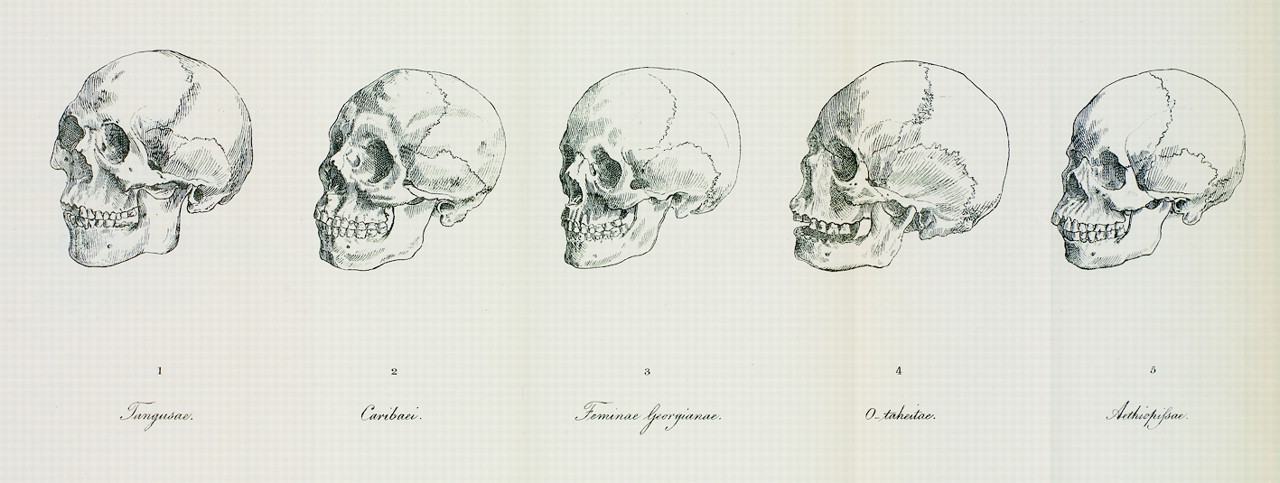 Figure \(\PageIndex{6}\): Five skull drawings representing specimens for Blumenbach’s “Mongolian,” “American,” “Caucasian,” “Malayan,” and “Aethiopian” races.
Figure \(\PageIndex{6}\): Five skull drawings representing specimens for Blumenbach’s “Mongolian,” “American,” “Caucasian,” “Malayan,” and “Aethiopian” races.“Race” and the Dawn of Scientific Racism
Between the 1800s and mid-1900s, and contrary to what you might expect, an increased use of scientific methods to justify racial schemes developed in scholarship. Differing from Blumenbach and Buffon’s views in earlier centuries, which saw all humans as environmentally deviated from one “original” humankind, classification systems after 1800 became more polygenetic (viewing all people as having separate origins) rather than monogenetic (viewing all people as having a single origin). Instead of moving closer to our modern-day understandings of human diversity, there was increased support for the notion that each race was created separately and with different attributes (intelligence, temperament, and appearance).
The 1800s were an important precursor to modern biological anthropology as we know it, given that the scientific measurement of human physical features (anthropometry) truly became popularized then. However, whether it was skin color, skull shape, or observations of behavior being analyzed as the data, empirical studies in the 1800s pushed the idea even further that Europeans were culturally and biologically superior. The leading figures in craniometry at this time, focusing on measurements of the skull, were also linked heavily with powerful individuals and wealthy sociopolitical institutions and financial bodies. Therefore, polygenetic ways of thinking were particularly influenced by sociohistorical and economic factors at the time. Theories in support of hierarchical racial schemes certainly helped continue the exploitative and unethical transatlantic slave trade between the 1500s and 1800s by justifying the transport and enslavement of African people on a “scientific” basis.
While considered one of the pioneers of American “physical” anthropology, Samuel George Morton (1799‒1851) was a scholar who had a large role in 1800s scientific racism. By measuring cranial size and shape, he calculated that “Caucasians,” on average, have greater cranial volumes than other groups, such as the Native Americans and “Negros.” Today, we know that cranial size variation depends on such factors as Allen’s and Bergmann’s rules, which give the more likely explanation for the largest heads being found in people living among colder regions (i.e., Europeans) being climatic adaptation (Beals et al. 1984). In colder environments, it is advantageous for those living there to have larger and rounder heads because they conserve heat more effectively than slenderer heads (Beals et al. 1984).
Morton went on to write in his publication Crania Americana (1839) a number of views that fit with a concept called biological determinism. The idea behind biological determinism is that an association exists between people’s physical characteristics and their behavior, intelligence, ability, values, and morals. If the idea is that some groups of people are essentially superior to others in cognitive ability and temperament, then it is easier to justify the unequal treatment of certain groups based on outward appearances. Based on his cranial measurements and observations of human nature, Morton claimed that Europeans were the most intelligent and “well-proportioned,” while Asians were not fit for leadership and had short attention spans, Native Americans were slow in acquiring knowledge and fond of war, and Africans were superstitious, uninventive, and “barbarous.”
Another such problematic thinker was Paul Broca (1824‒1880), after which a region of the frontal lobe related to language use is named (Broca’s area). Influenced by Morton, he likewise claimed that internal skull capacities could be linked with skin color and cognitive ability. Considering his data taken from different parts of the globe, Broca thought that factors such as gender, education, and social status could have an influence on brain size for different groups, purporting that men had larger brains than women and that “eminent” men were superior to men of “mediocre talent.” He went on to justify the European colonization of other global territories by purporting it was noble for a biologically more “civilized” population to improve the “humanity” of more “barbaric” populations. Today, these theories of Morton, Broca, and others like them are known to have no scientific basis. If we could speak with them today, they would likely try to emphasize that their conclusions were based on empirical evidence and not a priori reasoning. However, we now can clearly see that their reasoning was biased and affected by prevailing societal views at the time.
“Race” and the Beginnings of Physical Anthropology
In the early 20th century, we saw a number of new figures coming into the science of human variation and shifting the theoretical focuses within. Most notably, these included Aleš Hrdlička and Franz Boas.
 Figure \(\PageIndex{7}\): Aleš Hrdlička (1869‒1943), a Czech anthropologist who founded the American Journal of Physical Anthropology.
Figure \(\PageIndex{7}\): Aleš Hrdlička (1869‒1943), a Czech anthropologist who founded the American Journal of Physical Anthropology.Aleš Hrdlička (1869‒1943) was a Czech anthropologist who moved to the United States. In 1903, he established the physical anthropology section of the National Museum of Natural History (Figure 13.8). In 1918, he founded the American Journal of Physical Anthropology, one of the foremost scientific journals disseminating bioanthropological research still today. As part of his work and the scope of the journal, he differentiated “physical anthropology” from other kinds of anthropology—he wrote that physical anthropology is “the study of racial anatomy, physiology, and pathology” and “the study of man’s variation” (Hrdlička 1918). In some ways, although the scope and technological capabilities of biological anthropologists have changed significantly, Hrdlička established an area of inquiry that has continued and prospered for over a hundred years.
Franz Boas (1858‒1942) was a German American anthropologist who established the four-field anthropology system in the United States and founded the American Anthropological Association in 1902. He argued that the scientific method should be used in the study of human cultures and the comparative method for looking at human biology worldwide. Boas’s specialization was in the study of skull dimensions with respect to race. After a long-term research project, he demonstrated how cranial form was highly dependent on cultural and environmental factors and that human behaviors were influenced primarily not by genes but by social learning. He wrote in one essay for the journal Science: “While individuals differ, biological differences between races are small. There is no reason to believe that one race is by nature so much more intelligent, endowed with great willpower, or emotionally more stable than another, that the difference would materially influence its culture” (Boas 1931:6). This conclusion directly contrasted with the theories of the past that relied on biological determinism. Biological anthropologists today have found evidence that corroborates Boas’s explanations: societies do not exist on a hierarchy or gradation of “civilizedness” but instead are shaped by the world around them, their demographic histories, and the interactions they have with other groups.
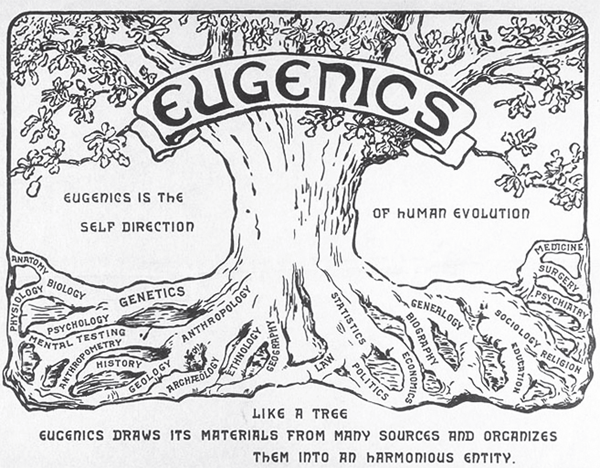 Figure \(\PageIndex{8}\): Logo of the Second International Exhibition of Eugenics held in 1921.
Figure \(\PageIndex{8}\): Logo of the Second International Exhibition of Eugenics held in 1921.The first half of the 1900s still involved some research that was essentialist and focused on proving racial determinism. Anthropologists like Francis Galton (1822‒1911) and Earnest A. Hooton (1887‒1954) created the field of eugenics as an attempt to formalize the social scientific study of “fitness” and “superiority” among members of 19th-century Europe. As a way of “dealing with” criminals, diseased individuals, and “uncivilized” people, eugenicists recommended prohibiting parts of the population from being married and sterilizing these members of society so they could no longer procreate (Figure 13.9). They instead encouraged “reproduction in individual families with sound physiques, good mental endowments, and demonstrable social and economic capability” (Hooton 1936). In the 1930s, Nazi Germany used this false idea of there being “pure races” to highly destructive effect. The need to be protected against admixture from “unfit” groups was their justification for their blatant racism and purging of citizens that fell under their subjective criteria.
Shortly after World War II and the Nazi Holocaust, the full extent of essentialist, eugenicist thinking became clear. Social constructions of race, and the notion that you could predict psychological or behavioral traits based on external appearance, had become unpopular both within and outside the discipline. It was up to those in the field of physical anthropology at the time to separate physical anthropology from race concepts that supported unscientific and socially damaging agendas. This does not mean that there are no physiological or behavioral differences between different members of the human species. However, going forward, a number of physical anthropologists saw human biological variation as more complicated than simple typologies could describe.

